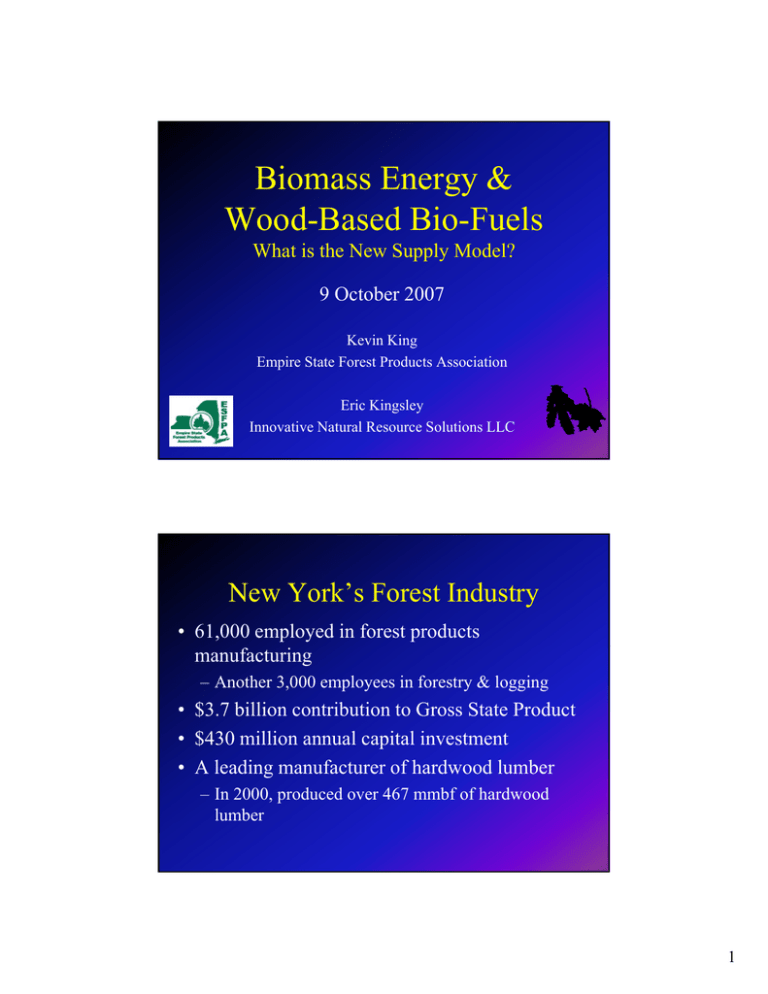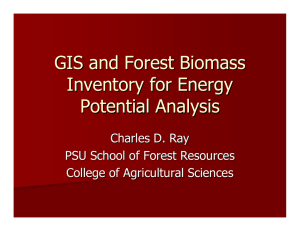Biomass Energy & Wood-Based Bio-Fuels What is the New Supply Model?
advertisement

Biomass Energy & Wood-Based Bio-Fuels What is the New Supply Model? 9 October 2007 Kevin Kingg Empire State Forest Products Association Eric Kingsley Innovative Natural Resource Solutions LLC New York’s Forest Industry • 61,000 employed in forest products manufacturing – Another 3,000 employees in forestry & logging • $3.7 billion contribution to Gross State Product • $430 million annual capital investment • A leading manufacturer of hardwood lumber – In 2000, produced over 467 mmbf of hardwood lumber 1 New York’s Forest Resource (Source: 2004 USDA Forest Service FIA Summary) • 18.4 18 4 million acres of forestland – 14.2 million acres (77%) in private ownership – 15.8 million acres (86%) classified as “timberland” • All above ground biomass = 971 million dry tons (about 1.8 billion green tons) – 71% in “bole” bole wood – The rest in stumps/tops/branches, seedling/sapling, or nongrowing stock – Would convert to about 78 billion gallons of ethanol, or roughly one half of annual U.S. gasoline consumption Forest Biorefineries, Wood Energy • Will need to find a way to integrate and build upon existing industry • Is reliant upon all the supply chain – landowners, loggers, foresters, truckers, mills, etc. • Policy issues important to most ESFPA members will be important to this industry • Will be (are) wholly reliant on others for feedstock – Unlike paper mills when built, which had land to serve as resource base 2 Sawmills • Producing high-value high value products, products enabling landowners, foresters and loggers to make money from owning, managing and harvesting • Products range from pallets to structural lumber to furniture • Health of this industry important to harvesting infrastructure New York Hardwood Sawmills 3 New York Softwood Mills – well distributed, not as much production New York’s Existing Users of Low Grade Wood Will Biorefining be compatible with existing industry? 4 Where Will the Wood Come From? Large Volumes of Wood Could be Needed 2,000 Dry Tons per Day = ~1.2 million green tons per year or 123 truckloads every day A High-Volume Harvesting System Can Cost over a Million Dollars Feller Buncher Grapple Skidder Stroke Delimber Providing stable markets to support this key to new investment 5 Will new types of equipment be needed? If so, what will work in New York woods? Feedstock transport, handling and storage are important parts of industry success 6 Large blocks of land or large harvests important to managing harvest costs Moving Cost per Ton vs Harvest Volume (tons) $4.00 Assumptions: $3.50 Moving Time = 12hrs Lowbed Cost per Hour = $70 Fixed Moving Cost = $840 Moving g Cost per Ton $3.00 $2.50 $2.00 $1.50 $1.00 $0.50 $0.00 0 500 1000 1500 2000 2500 3000 3500 4000 4500 5000 5500 6000 6500 7000 7500 8000 Harvest Volume (Tons) Maintaining and Building New York’s Biomass Harvesting Infrastructure • Maintain the land base and large ownerships – tax policy, markets • Maintain and grow high-value markets – sawmills • Provide economic opportunity for l d landowners andd loggers l • Integrate with existing markets • Addressing sustainability issues before others do 7 New York has an Excellent Hardwood Resource Percent of Standing Timber (cu. ft.) HW by county 8 New York has forests dense with hardwoods (cubic feet of hardwood per acre in a county) Challenges for New Large Biomass Facilities • Breakingg into a difficult marketplace p – Constrained wood availability (?) • High capital costs • Limited size of facilities – constrained by transport cost for low-value, high moisture wood • Lack of transparent wood market • Instability of public policy – new plants built in part on public policy 9 Project: Establishing Long-Term Supply Agreements for Wood Energy Facilities • • • • • Empire State Forest Products Association Innovative Natural Resource Solutions LLC Sustainable Energy Associates Antares Group Funding from: – USDA Forest Service – NYSERDA Biomass Challenged by Two Myths The Myth of Free Wood – a belief b li f on the th partt off some developers d l that th t wood should be free or close to free – thinking of it as waste (residue), not as a product that has embedded costs Reality: The growing, harvesting, skidding, processing and transport of wood has costs. 10 Biomass Challenged by Two Myths The “Oil Sheik” Landowner – • landowner or supplier belief that energy projects will be able to pay “unlimited” prices for wood, as energy is highly valuable Reality: What users can pay is limited by the laws of physics (a tons of wood contains only so much energy), the market (the product is worth only so much), and the need for the processor to make a reasonable profit. 1 Green Ton of Wood 1 truck = ~30 green tons • 1 1.7 7 MWH of electricity • 40 gallons of ethanol 11 Feedstock Costs Wood Cost (Delivered) Electricity ($ per kwh) Ethanol ($ per gallon) $ 10 $ 00.017 01 $ 0.25 02 $ 20 $ 0.034 $ 0.50 $ 30 $ 0.051 $ 0.75 $ 40 $ 00.068 068 $ 1.00 1 00 $ 50 $ 0.085 $ 1.25 Does not include operations & maintenance, debt service, profit Electricity ~ $0.055, Friday’s CBOT Ethanol $1.58 Wood and Oil Prices, 1995 – 2006 Wood (Northern NH) Oil 30 80 70 30 20 Oil ($/barrel) 50 40 20 10 06 05 06 3Q 1Q 04 05 3Q 1Q 04 3Q 03 03 3Q 1Q 02 02 1Q 3Q 01 1Q 01 3Q 1Q 00 99 00 3Q 1Q 99 3Q 98 98 1Q 3Q 97 1Q 96 97 3Q 1Q 3Q 1Q 96 0 95 15 3Q Wood ($/ton) 60 25 Data Sources: NHTOA Timber Crier, US DOE Energy Information Agency 12 $ per ton (wood) / $ per barrell (oil) Wood and Oil Prices , Trend Line 1995 – 2006 80 75 70 65 60 55 50 45 40 35 30 25 20 15 10 5 06 3Q 06 05 3Q 1Q 05 04 3Q 1Q 04 03 3Q 1Q 02 03 1Q 3Q 01 02 1Q 01 3Q 00 00 1Q 1Q 3Q 99 99 1Q 3Q 98 98 1Q 3Q 97 97 3Q 1Q 96 96 1Q 3Q 3Q 95 0 Data Sources: NHTOA Timber Crier, US DOE Energy Information Agency Wood Supply is a Critical Piece of Biomass Projects • Can represent ~80% of operating costs • No N ttransparentt market, k t no futures f t market k t • A disconnected supply chain (landowner, loggers, truckers) • A belief on the part of suppliers that prices will ggo up, p and a reluctance commit to ppricingg • Inability of suppliers to accurately forecast and hedge their price structure • Suppliers are small and don’t meet institutional credit guidelines 13 Addressing Wood Supply • Project goal to find ways that suppliers and projects developers can work together to make projects happen • Models that meet the needs of all parties • Address forest sustainabilityy issues • Develop a model that can be used in other regions, in other parts of the forest industry Process - 1 • Interviews with a sample p of suppliers, pp , developers and financial institutions • Interviews are (just) now underway • In-depth conversation – about 20 minutes 14 Process - 2 Evaluate options A. B. C. D. E. Biomass futures market Shared reward contracts Supplier cooperatives / resource pooling Harnessing other futures markets Direct partnership Process - 3 • 1 day workshop including suppliers, developers, financers • Bring all interview participants together • Discuss options, p findings, g recommendations • Seek feedback / input / ideas 15 Process - 4 Develop a path forward • Core idea(s) • Business plan • Partners • Funding Innovative Natural Resource Solutions LLC 107 Elm Street, Suite 100-E Portland, ME 04101 207/772 5440 207/772-5440 Kingsley@inrsllc.com Empire State Forest Products Association 828 Washington g Ave. Albany, NY 12203 518/463-4200 kking@esfpa.org 16




